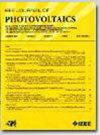v坑对氮化镓基高周期性多量子阱太阳能电池导通电压的影响
IF 2.5
3区 工程技术
Q3 ENERGY & FUELS
引用次数: 0
摘要
基于电学分析、显微镜研究和二维模拟,我们研究了V型凹坑对高周期InGaN-GaN多量子阱太阳能电池导通电压和电流-电压特性的影响。实验测量表明,具有最薄p-GaN层的样品表现出早期导通,而对于较厚的p-GaN层则不存在这种情况。通过技术计算机辅助设计(TCAD)模拟,我们表明早期开启是由于V形坑平面化不足,扫描电子显微镜和透射电子显微镜分析证明了这一点。V型坑穿透结,并使量子阱区域与p侧接触更紧密地连接。该结果深入了解了V型坑对高周期量子阱器件电性能的影响,并证明了在需要薄p-GaN(以限制短波长吸收)和厚p-GaN之间存在折衷,以利于V型坑平坦化。本文章由计算机程序翻译,如有差异,请以英文原文为准。
Influence of V-Pits on the Turn-On Voltage of GaN-Based High Periodicity Multiple Quantum Well Solar Cells
Based on combined electrical analysis, microscopy investigation, and two-dimensional simulations we investigate the influence of V-pits on the turn-on voltage and current-voltage characteristics of high periodicity InGaN-GaN multiple quantum wells solar cells. Experimental measurements indicate that the sample with the thinnest p-GaN layer presents an early turn-on, which is not present for thicker p-GaN layers. Through technology computer aided design (TCAD) simulations, we show that the early turn-on is due to the insufficient V-pit planarization, as demonstrated by scanning electron microscopy and transmission electron microscopy analysis. V-pits penetrate the junctions, and locally put the quantum well region in closer connection with the p-side contact. The results provide insight on the role of V-pits on the electrical performance of high-periodicity quantum well devices, and demonstrate the existence of a trade-off between the need of a thin p-GaN (to limit short-wavelength absorption) and a thicker p-GaN, to favor V-pit planarization.
求助全文
通过发布文献求助,成功后即可免费获取论文全文。
去求助
来源期刊

IEEE Journal of Photovoltaics
ENERGY & FUELS-MATERIALS SCIENCE, MULTIDISCIPLINARY
CiteScore
7.00
自引率
10.00%
发文量
206
期刊介绍:
The IEEE Journal of Photovoltaics is a peer-reviewed, archival publication reporting original and significant research results that advance the field of photovoltaics (PV). The PV field is diverse in its science base ranging from semiconductor and PV device physics to optics and the materials sciences. The journal publishes articles that connect this science base to PV science and technology. The intent is to publish original research results that are of primary interest to the photovoltaic specialist. The scope of the IEEE J. Photovoltaics incorporates: fundamentals and new concepts of PV conversion, including those based on nanostructured materials, low-dimensional physics, multiple charge generation, up/down converters, thermophotovoltaics, hot-carrier effects, plasmonics, metamorphic materials, luminescent concentrators, and rectennas; Si-based PV, including new cell designs, crystalline and non-crystalline Si, passivation, characterization and Si crystal growth; polycrystalline, amorphous and crystalline thin-film solar cell materials, including PV structures and solar cells based on II-VI, chalcopyrite, Si and other thin film absorbers; III-V PV materials, heterostructures, multijunction devices and concentrator PV; optics for light trapping, reflection control and concentration; organic PV including polymer, hybrid and dye sensitized solar cells; space PV including cell materials and PV devices, defects and reliability, environmental effects and protective materials; PV modeling and characterization methods; and other aspects of PV, including modules, power conditioning, inverters, balance-of-systems components, monitoring, analyses and simulations, and supporting PV module standards and measurements. Tutorial and review papers on these subjects are also published and occasionally special issues are published to treat particular areas in more depth and breadth.
 求助内容:
求助内容: 应助结果提醒方式:
应助结果提醒方式:


